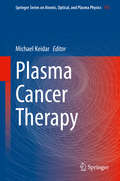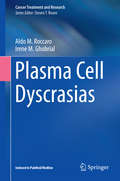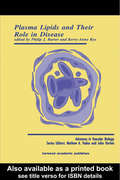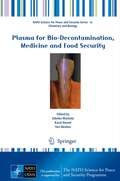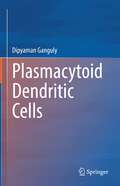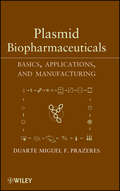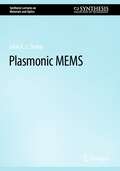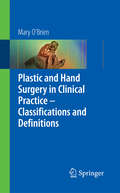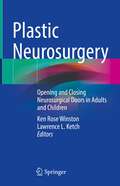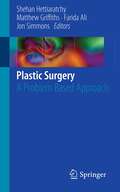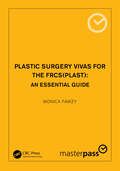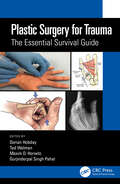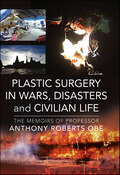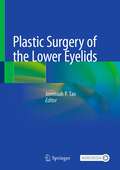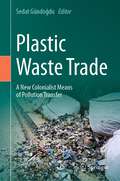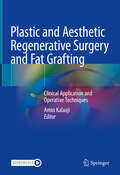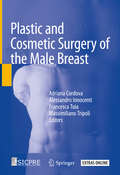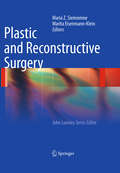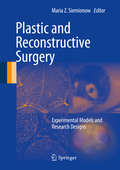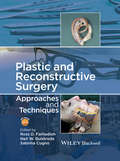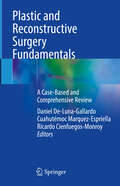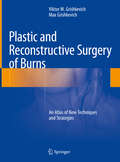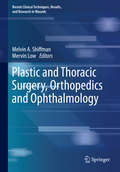- Table View
- List View
Plants for Immunity and Conservation Strategies
by Manoj Kumar Mishra Nishi KumariThis edited book deals with medicinal plants (herbs and trees) used in critical diseases which contain a rich resource of bioactive compounds that can be used as immuno-boosters or recommended for therapeutic values. Each chapter provides the basic information such as taxonomic description, occurrence and importance of medicinal plants. The detail description of major bioactive compounds in medicinal plants, their chemical nature and clear flow chart of biosynthesis are important steps in this book. This book also includes conservation strategy both in-situ and ex-situ, which assist the research and academic purpose. This book is of interest to national and international researchers, teacher’s, pharma scientists, and policymakers. Also, the book serves as additional reading material for both undergraduate and graduate students of pharma and agriculture in the world.
Plasma Cancer Therapy (Springer Series on Atomic, Optical, and Plasma Physics #115)
by Michael KeidarThis book, written by key researchers in the field, provides a comprehensive analysis and overview of the state of the art of plasma-based cancer therapy. Recent progress in atmospheric plasmas has led to non-thermal or cold atmospheric plasma (CAP) devices with ion temperatures close to room temperature. In contrast to many existing anti-cancer approaches, CAP is a selective anti-cancer modality which has demonstrated significant potential in cancer therapy.Written by a global, cross-disciplinary group of leading researchers, this book covers basic theory, generation, diagnostics, and simulation of cold atmospheric plasma, as well as their clinical application in cancer therapy, immunotherapy, and future outlook, giving a complete picture of the field.It is meant for a broad audience, from students to engineers and scientists, who are interested in the emerging world of plasma medical applications. It presents recent advances, primary challenges, and future directions of this exciting, cutting-edge field.
Plasma Cell Dyscrasias
by Irene M. Ghobrial Aldo M. RoccaroThis book provides a concise overview of the state of the art in the biology and treatment of plasma cell malignancies, a heterogeneous group of diseases primarily characterized by the presence of clonal plasma cells within the bone marrow or extramedullary sites. The plasma cell dyscrasias investigated include monoclonal gammopathy of undetermined significance (MGUS), multiple myeloma, plasmacytoma, immunoglobulin deposition diseases (primary amyloidosis and systemic light and heavy chain deposition diseases), and Waldenström's macroglobulinemia. In the case of multiple myeloma, the coverage ranges from genomic aberrations and microRNAs to treatment for different patient groups, upcoming novel therapies, immunotherapy, and transplantation. The book reflects the significant research advances achieved in this field during the past few years, which have enhanced our understanding of the molecular mechanisms responsible for the pathogenesis of plasma cell dyscrasias.
Plasma Lipids and Their Role in Disease (Advances in Vascular Biology)
by Philip J. Barter Kerry-Anne RyeThis volume gives up-to-date information on plasma lipid transport, the various categories of plasma lipid disorders and the relationship between plasma lipids, lipoproteins, and atherosclerotic disease.
Plasma Medicine
by M. Laroussi G. Morfill W. Stolz M. KongThe introduction of low temperature plasma technology to medical research and to the healthcare arena in general is set to revolutionise the way we cure diseases. This innovative medium offers a valid and advantageous replacement of traditional chemical-based medications. Its application in the inactivation of pathogens in particular, avoids the recurrent problem of drug resistant microorganisms. This is the first book dedicated exclusively to the emerging interdisciplinary field of plasma medicine. The opening chapters discuss plasmas and plasma chemistry, the fundamentals of non-equilibrium plasmas and cell biology. The rest of the book is dedicated to current applications, illustrating a plasma-based approach to wound healing, electrosurgery, cancer treatment and even dentistry. The text provides a clear and integrated introduction to plasma technology and has been devised to answer the needs of researchers from different communities. It will appeal to graduate students and physicists, engineers, biologists, medical doctors and biochemists.
Plasma for Bio-Decontamination, Medicine and Food Security
by Karol Hensel Yuri Akishev Zdenko MachalaNon-thermal (cold) plasmas at atmospheric pressure have recently found many breakthrough applications in biology, medicine, and food security. Plasmas can efficiently kill bacteria, yeasts, moulds, spores, biofilms and other hazardous microorganisms, including potential bio-terrorism agents. They can be employed for bio-decontamination and sterilization of surfaces, medical instruments, water, air, food, even of living tissues without causing their damage. Direct or indirect plasma interaction with living cells of microorganisms or even humans enables novel bio-medical applications, e.g. treatment of skin diseases and ulcers. Plasma-enhanced blood coagulation coupled with its antiseptic properties proved success in wound healing and opens new possibilities in surgery, emergency medicine and military applications. Plasma treatment allows cell manipulations, their removal and targeted transfer into the injured area, which can accelerate wound healing. Plasma induced apoptosis (programmed cell death) of tumor cells brings forth a great potential for cancer treatment. Besides, plasma enables painless treatment of dental caries, root canal disinfection, and other dentistry applications. This book is a selection of reviewed manuscripts issuing from the NATO Advanced Research Workshop Plasma for bio-decontamination, medicine and food security held in Jasná, Slovakia, on 15-18 March 2011. It provides a comprehensive overview of the current knowledge and research activities focused at the plasma applications in areas such as bio-decontamination, water chemistry, effects on cells; biofilm inactivation, UV sterilization, and medicine, especially tissue treatment and wound healing, as well as dentistry and food security.
Plasmacytoid Dendritic Cells
by Dipyaman GangulyThis book provides a systematic review of the development, function, and patho-physiologic role of plasmacytoid dendritic cells (pDCs) in humans. The chapters of the book discuss the origin and discovery, hematopoietic development as well as molecular regulation of pDCs in the context of immune activation as well as immune tolerance. It also discusses the role of pDCs in human diseases, including infections, autoimmune/inflammatory diseases, cancers and metabolic disorders, and opportunities for pDC‐targeting therapies in these varied clinical contexts.
Plasmid Biopharmaceuticals
by Duarte Miguel PrazeresThe book addresses the basics, applications, and manufacturing of plasmid biopharmaceuticals. The survey of the most relevant characteristics of plasmids provides the basics for designing plasmid products (applications) and processes (manufacturing). Key features that the authors include in the book are: i) consistency and clear line of direction, ii) an extensive use of cross-referencing between the individual chapters, iii) a rational integration of chapters, iv) appellative figures, tables and schemes, and v) an updated, but selected choice of references, with a focus on key papers.
Plasmonic MEMS (Synthesis Lectures on Materials and Optics)
by John X. ZhangThis book covers key topics in the emerging field of plasmonic MEMS, with an emphasis on practical aspects. Although readers can find many comprehensive textbooks on electromagnetic waves, nanophotonics and plasmonics, most of these lack the focus needed for a thorough grasp of plasmonic micromachining and MEMS.This book introduces the main framework of plasmonic MEMS, providing an overview of introductory concepts, a thorough description of the basic foundations, along with the state-of-the-art and existing challenges. The author presents an abbreviated overview of the basic physics and devices related to electromagnetic waves and surface plasmons. Additional coverage includes recent advances in the fabrication of sub-100-nm patterns on micro scale devices and structures and a review of emerging techniques in the fabrication of plasmonic systems. A comprehensive and historical review of the current advances in the area of plasmonic nanofabrication is also included.This book focuses on an appealing and distinctive aspect of plasmonics, as a tool for patterning and the fabrication of ultra-fine resolution structures. The author reviews the recent developments in plasmonic MEMS and microsystems for biosensing applications, including refractive-index based label-free biosensing, plasmonic integrated lab-on-chip systems, plasmonic for near-field scanning optical microscopy (NSOM) and plasmonics on-chip system for cellular imaging.
Plastic & Hand Surgery in Clinical Practice
by Mary O'BrienProvides an easy reference aid for those involved in the field of Plastic Surgery. Plastic surgery is a large and diverse field and therefore this book would serve as a framework or skeleton on which to base answers to questions relating to the individual components of the topic. It would be useful to students of the specialty in addition to those involved in teaching. Provides definitions: a particularly helpful way to engage in answering a question.- Provides classifications: neatly distils a large topic into a manageable framework.- Provides references of recognised classifications: a question often asked of trainees on a variety of topics.- Provides simple diagrams: often asked to draw sketches by trainers and patients.- Succinct: removes excessive padding and provides a sound backbone of knowledge without the reader having to painfully extract information from an elaborate text. Certain chapters of the book would appeal to a range of surgeons not only plastic surgeons but those involved in orthopaedics, hand surgery, urology, maxillofacial and craniofacial specialties. The incorporation of a medicolegal chapter significantly widens readership across the medical specialties and perhaps into the legal sphere. (The author has a degree in Medical Law in addition to Medicine). Certain chapters would also be of interest to other professions allied to medicine e.g. plastic surgery specialist nurses, occupational therapists, speech therapists with an interest in cleft.
Plastic Neurosurgery: Opening and Closing Neurosurgical Doors in Adults and Children
by Ken Rose Winston Lawrence L. KetchThis is the definitive text for the intersection of neurosurgery and plastic surgery, a crucial and undertreated subject. It is a comprehensive, stand-alone and topically organized book that provides a synthesis of information, experience and wisdom for practitioners of adult and pediatric neurosurgery, including all subspecialties.The first of the three parts of the book includes foundational information on normal and abnormal anatomy, wound healing and surgical details for the management of skin, fascia, muscle, bone and dura, important subjects which receive little attention in neurosurgical literature. The second part of the book consists of descriptions of the plastic components – i.e., the opening and closing for neurosurgical approaches. Neurosurgical approaches are presented in three groups: intracranial, spinal and exposure of peripheral nerves. The plastic neurosurgical concerns for each approach are emphasized, and each chapter includes citations of relevant sources. The third part of the book presents the plastic neurosurgery of cranial and craniofacial disorders and the role of neurosurgeons in these surgeries, which are often performed with plastic surgeons. All neurosurgeons, particularly in the formative years of their residencies and fellowships, should learn and never forget not only the what and how but also the why of the plastic components of neurosurgery. This text fills this important gap in the literature.
Plastic Surgery
by Matthew Griffiths Shehan Hettiaratchy Farida Ali Jon SimmonsPlastic Surgery, A Problem Based Approach provides a problem-based approach to solutions for common scenarios in plastic, reconstructive and aesthetic surgery and serves as a practical guide to managing a plastic surgical case. This book outlines a pathway through management for the clinician, consisting of six phases: 1) Recognition of the condition: facilitated by high quality images. 2) General approach: provided by an opening "mindset" statement for the particular case. 3) Assessment: the critical aspects of the history and examination. 4) Treatment: key decisions and key interventions. 5) Management: post-intervention expectations. 6) Evidence: the rationale behind the preceding treatment and an overview of any controversies. Plastic Surgery, A Problem Based Approach is a valuable reference tool for surgical trainees, medical students, healthcare professionals and plastic and reconstructive surgeons.
Plastic Surgery Vivas for the FRCS: An Essential Guide (Master Pass Series)
by Monica FawzyThis is the first Q&A-based revision book specifically aimed at candidates sitting the viva component of the FRCS(Plast) examination. It provides a selection of common clinical scenarios presented in a realistic way and presents a guide to answering the FRCS (Plast) questions, as well as advice on how to approach the revision process itself. Crucially, this will help to prepare candidates to organise their thoughts, demonstrate higher order thinking and present a robust answer in the face of grey areas and controversies. The text covers all topics from the syllabus including Trauma, Burns, Facial and Soft Tissue Injuries, Acute Head and Neck Tumours, Cleft and Craniofacial, Congenital anomalies, Facial Palsy, Vascular anomalies, Trunk & Perineal, Skin Cancer, Basic Sciences, Aesthetic, Ethics & Medico-legal, and Consent. Candidates using this book will be able to realistically recreate the exam scenario either in private or in a group setting. This book is equally useful for candidates sitting plastic surgery post graduate exams with equivalent syllabuses to that of the FRCS(Plast) such as the EBOPRAS exam, as well as others. In addition, it also makes an excellent companion for trainees throughout the course of their six-year training rotation, allowing more junior plastic surgery trainees the opportunity to become acquainted with the format and content of the FRCS (Plast) exam. Lastly it may be helpful to consultants who are interested in coaching their trainees in topics other than their subspeciality.
Plastic Surgery for Trauma: The Essential Survival Guide
by Dorian HobdayCovers the immediate assessment and management of common plastic and reconstructive surgery emergencies and referrals. A companion for junior doctors starting within plastic surgery, the Plastic Surgery for \Trauma provides succinct and clear presentation together with up to date guidelines on the common plastic surgery emergencies. With clear descriptions of difficult trauma scenarios, illustrated with numerous figures, and updated guidelines for each step of practice, this book will ensure that the reader can access all the information required to help gain confidence and experience .Be the readers passing through a plastic surgery rotation on their way to some other career goal or beginning within plastic surgery and keen to make a strong start with a view to progressing in the speciality, this book provides the support to allow rational and confident clinical decision making from the start. Essential reading for all non-specialists and trainees.
Plastic Surgery in Wars, Disasters and Civilian Life: The Memoirs of Professor Anthony Roberts OBE
by Anthony RobertsThe specialty of plastic surgery was developed and named by Sir Harold Gillies following his work between the two world wars reconstructing severely damaged servicemen from the First World War. Sir Harold went on to inspire and train other surgeons from around the world. Among them was his cousin Sir Archibald McIndoe, who in the Second World War set up the unit at East Grinstead Hospital which looked after severely burned airmen and some other servicemen. The airmen themselves set up the famous Guinea Pig Club which gave enormous social and often financial support to the severely injured. After the Second World War specialized burn units were created throughout the UK, including one at Stoke Mandeville Hospital, where Anthony Roberts served. After the number of war injuries had reduced, the burn unit for all three services was set up at RAF Halton, a few miles from Stoke Mandeville. A close relationship between the hospitals developed which led to military surgeons being posted to Stoke Mandeville for training in the care of burns and an introduction to plastic surgery. Most doctors will never be involved in a disaster during their working lives. Anthony Roberts was involved in treating casualties from the Bradford City football stadium fire in 1985 that claimed 56 lives and resulted in hundreds more being injured, many of them with severe burns. It had a major effect on him, and on all those involved. It started his appearances on the media and his overseas visits to other countries to talk about it. And subsequently he was asked to join and to lead other international efforts to provide help. He led the first British team from Stoke Mandeville that gave aid in Sarajevo during the war. He returned several times and has also given aid in three other war zones and six major disasters. Because of this involvement in all these situations Professor Roberts taught junior trainee surgeons from the three British services and those of several foreign countries. As well as his military involvement, Anthony Roberts spent sixteen years working with the Royal Protection Group at State occasions, and thirty years working as a motor racing track doctor including at Formula One level, providing immediate and vital treatment to drivers who suffered serious injuries and burns following accidents on the track and to spectators. There have been enormous changes in the specialty over the past fifty years and a detailed view of these is given in an absorbing account of this life-enhancing surgery by one who served on the frontline in difficult and dangerous situations around the world.
Plastic Surgery of the Lower Eyelids
by Jeremiah P. TaoThis textbook details knowledge and techniques required for the management of a broad spectrum of lower eyelid malposition, conditions, and cosmetic surgery. The lower eyelids are very prone to malposition and even mild scarring or slight irregularities cause patient dissatisfaction. Ectropion, lagophthalmos, and retraction are common results of attempts to repair or rejuvenate the periocular area, but also pose serious risks to the eye. Skills in forestalling these issues as well as repairing them when they do are occur are paramount for any facial surgeon and are covered throughout the textbook.Plastic Surgery of the Lower Eyelids explores solutions and treatment of the spectrum of lower eyelid conditions and aesthetic concerns. It also highlights both functional and cosmetic surgery of the lower eyelids and cheeks that often co-exist. In addition to treatments for eyelid retraction that occurs after cosmetic lower eyelid surgery, this textbook details maneuvers that forestall malposition when performing aesthetic surgery. Residents, fellows and clinicians in oculoplastic surgery, ophthalmology, plastic surgery and other related fields will find this textbook to be an essential guide for delivering safe and effective lower eyelid surgery.
Plastic Waste Trade: A New Colonialist Means of Pollution Transfer
by Sedat GündoğduThis contributed volume takes a holistic view of the international waste trade and in doing so argues that the transfer of plastic waste from mainly Global North to primarily Global South countries constitutes a form of 21st Century colonialism. The book first describes the history of the plastic waste trade, from toxic disasters in the 1970s and 1980s through the Basel Convention on the Control of Transboundary Movements of Hazardous Wastes and Their Disposal in 1989 through China’s 2018 implementation of a “National Sword” policy that effectively banned importation of plastic waste. From there, the authors explore both the legal trade in plastic waste and the underground illegal trade in waste, arguing that both lead to devastating impacts on ecosystems, workers, and communities in receiving countries and highlighting how countries that receive waste are often less equipped to process it than the countries that export waste. The last section of the book presents cases from countrieson the receiving end of the plastic waste trade, highlighting inherent problems from sociological and environmental justice perspectives.
Plastic and Aesthetic Regenerative Surgery and Fat Grafting: Clinical Application and Operative Techniques
by Amin KalaajiReaders will discover the relatively new and rapidly growing field of regenerative surgery and fat grafting, valuable for numerous plastic surgery, reconstructive, and aesthetic/cosmetic essentials. Though many books have covered specific areas or topics in regenerative surgery, the market lacks a work that tackles the full spectrum of regenerative surgery and its clinical application. This book responds to that need and presents chapters written by the best: world-renowned surgeons in their field. After an introduction that reflects basic research, most of the book focuses on clinical experience as it relates to applied techniques of processing fat and on the different uses from head to toe. Readers will learn about the history of regenerative surgery, important definitions and background information, and the evidence supporting the use of regenerative surgery. Practitioners will also find valuable guidance regarding the application of stem cells, evaluation of patient needs, and operative techniques for fat transfer. Subsequent chapters address topics such as graft types, the skin, wound healing, scar treatment, osteoarthritis, burns, scleroderma, hair rejuvenation, facial enhancement combined with facelift, chin augmentation with fat, and breast argumentation or reconstruction with fat. Particular attention is paid to gluteal augmentation with fat, body contouring, genital male and female rejuvenation, and upper and lower extremity regenerative surgery. Surgical anatomy and complications treatment and prevention were emphasized when applied. This resulted is two volumes that encompass 114 chapters, with multiple figures, and video clips, written by 242 authors (including 72 female colleagues) from five continents. Highly informative and carefully structured, this book provides invaluable insight for beginners and experienced plastic surgeons alike, while benefitting advanced surgeons, specialists, and undergraduate and graduate students.
Plastic and Cosmetic Surgery of the Male Breast
by Adriana Cordova Alessandro Innocenti Francesca Toia Massimiliano TripoliThe thorax has a fundamental role in the aesthetic of the male body: congenital or acquired alterations are experienced as extremely frustrating clinical situations. Most breast surgery texts briefly mention gynecomastia, but no text comprehensively addresses the male breast and thorax, including reconstructive and cosmetic surgery and surgery in transgender patients. This gap is now thoroughly filled by Plastic and Cosmetic Surgery of the Male Breast: after introducing principles of anatomy and aesthetics for the male thorax, the first part focusses on the main congenital malformations and their treatment; the main benign acquired pathologies and their treatment (including an ample section dedicated to gynecomastia), the carcinoma of the male breast, with reference to familiar forms; the treatment of carcinoma and reconstruction of the thorax. The book closes with a chapter dedicated to breast surgery in transgender patients. While female breast surgery is increasingly practiced in specific Breast Units and highly specialized centers, male breast issues are treated in general and plastic surgeries units. This handy volume is a sound reference for the most complex clinical cases, and the latest reconstruction treatments for the male thorax and will be useful for general and thoracic surgeons, plastic surgeons and senologists.
Plastic and Reconstructive Surgery
by Maria Z. Siemionow Marita Eisenmann-KleinDue to the multidisciplinary approach presentation of the basic plastic surgery knowledge with adjustment to new technologies, the book targets not only plastic surgeons but also hand, microsurgeons, hand and neck specialists, and breast surgeons. It will be of great interest to young surgeons in training for fast comprehensive overview of plastic surgery when preparing for board exams as well as envision the future of new surgical technologies and make the decision on their sub-specialty choice.
Plastic and Reconstructive Surgery
by Maria Z. SiemionowThere is a paradigm shift in plastic and reconstructive surgery from the interest of developing new surgical techniques into the application of new technologies via research based studies on stem cells, tissue engineering and new field of reconstructive transplantation such as e. g. face, hand or larynx transplants. This approach is relatively novel and introduced to plastic surgery within past decade. Thus there is an urgent need to facilitate access to this new knowledge which was not traditionally a part of plastic surgery curriculum. The most efficient way of introducing these new approaches is via presentation of pertinent to different fields (stem cell, transplantation, nerve regeneration, tissue engineering) experimental models which can be used as a tool to develop technologies of interest by different groups of surgeons. These surgical specialities which will be interested and benefit from the book include: plastic and reconstructive surgeons, microsurgeons, hand surgeons, orthopaedic surgeons, neurosurgeons and transplant surgeons.
Plastic and Reconstructive Surgery
by Neil Bulstrode Ross Farhadieh Sabrina CugnoPlastic and reconstructive surgery continues to evolve as new techniques open up new possibilities for the surgeon. In this groundbreaking textbook, contemporary approaches are explained and demonstrated to allow trainee and experienced surgeons alike to understand and assimilate best practice. Containing over 300 outstanding color figures demonstrating surgical practice, an international cast of leading surgeons show the paths to effective plastic surgery technique and outcomes. They cover all the major bases including: Integument Pediatric Plastic Surgery Head and Neck Reconstruction The Breast Trunk, Lower Limb and Sarcomas Upper Limb and Hand Surgery Aesthetic Surgery Comprehensive in scope, practical in nature, Plastic and Reconstructive Surgery is your one-stop guide to successful surgical management of your patients.
Plastic and Reconstructive Surgery Fundamentals: A Case-Based and Comprehensive Review
by Daniel De-Luna-Gallardo Cuahutémoc Marquez-Espriella Ricardo Cienfuegos-MonroyPlastic and reconstructive surgery represents one of the broadest and most extensive medical specialties, where the pathologies studied can range from head to toe. The abundance of information generated from established or new concepts, knowledge, and techniques are difficult to assimilate and apply in daily medical practice, so the reader may get lost on the journey from time to time. This up-to-date book provides key elements of plastic and reconstructive surgery in a practical and useful approach. It enhances understanding through questions and answers, clinical cases, algorithms, and tips and tricks. The questions and answers reflect what is frequently asked in written or clinical examinations of all stripes, making this title a complement tool which allows the readers to check whether the content is being retaining. Divided in sixteen sections, this work encompasses fundamentals concepts, sutures and needles, flaps, grafts, tissue expansion, anesthesia and burns, among other various relevant topics. It also features illustrative pictures, clinical maneuvers, pathognomonic signs and trans operative and postoperative key events. Plastic and Reconstructive Surgery Fundamentals - A Case-Based and Comprehensive Review is developed for plastic and reconstructive surgery residents and graduates, general surgeons, dermatologists and medical students interested in the area. It will also serve as a support guide for the initial and subsequent certification of any council of plastic, aesthetic and reconstructive surgery.
Plastic and Reconstructive Surgery of Burns: An Atlas of New Techniques and Strategies
by Viktor M. Grishkevich Max GrishkevichThis comprehensive atlas provides a step-by-step guide of new techniques in burn surgery and enables readers to identify the appropriate treatment plan and best possible procedure for each patient pre-surgery before delving into a variety of different surgical possibilities for treatment and recovery. Plastic and Reconstructive Surgery of Burns – An Atlas of New Techniques and Strategies presents new solutions in plastic and reconstructive surgery for burns built upon tried and true techniques of contracture restoration using various flaps and skin grafts. Accompanying illustrations and schemes allow the reader to visualize the process from mapping, dissecting and closing the wound. Preoperative and postoperative results are compared, with extensive illustrations and pictures that cover areas of the body most commonly treated for burns including face, neck, breast, torso, arms, legs, hands, and feet. Outcomes of the surgeries including full functional and aesthetic restoration of treated patients are meticulously photographed and provided alongside each technique. New classifications are presented based on contracture anatomy which showcase the development of new flaps and techniques that elevate functional and aesthetic rehabilitation of burned patients to a new level.The culmination of the decades long career of renowned plastic surgeon, Viktor M. Grishkevich, many new and original techniques, currently unpublished in U.S. literature, are detailed in depth alongside techniques uniquely designed by Dr. Grishkevich and previously published around the world. Plastic and Reconstructive Surgery of Burns – An Atlas of New Techniques and Strategies, has international reach and is meant for plastic and reconstructive surgeons with specialties inhand, maxillo-facial, facial, and ENT. Due to its detailed nature, the atlas is also appropriate for residents in the related fields of surgery as well.
Plastic and Thoracic Surgery, Orthopedics and Ophthalmology (Recent Clinical Techniques, Results, and Research in Wounds #4)
by Melvin A. Shiffman Mervin LowThis book deals with wound management in plastic surgery, orthopedics, ophthalmology and thoracic surgery. The first part provides information on the latest developments in orthopedic surgery, while the second addresses ophthalmology and wounds after e.g. cataract surgery or keratopathy. The third part, which exclusively focuses on wounds in plastic surgery, highlights recent results after microsurgical procedures and keloid reconstruction, but also after breast reconstruction and limb injuries. Lastly, the part on thoracic surgery informs the reader about sternotomy techniques and possible complications. Given it interdisciplinary approach, this book offers a valuable resource not only for plastic surgeons, but also for ophthalmologists, thoracic surgeons and orthopedic surgeons.

